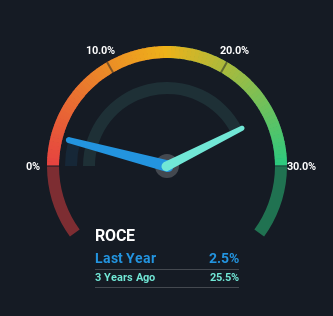The Returns On Capital At Nahar Spinning Mills (NSE:NAHARSPING) Don't Inspire Confidence
If you're looking for a multi-bagger, there's a few things to keep an eye out for. One common approach is to try and find a company with returns on capital employed (ROCE) that are increasing, in conjunction with a growing amount of capital employed. Basically this means that a company has profitable initiatives that it can continue to reinvest in, which is a trait of a compounding machine. However, after investigating Nahar Spinning Mills (NSE:NAHARSPING), we don't think it's current trends fit the mold of a multi-bagger.
Understanding Return On Capital Employed (ROCE)
For those that aren't sure what ROCE is, it measures the amount of pre-tax profits a company can generate from the capital employed in its business. Analysts use this formula to calculate it for Nahar Spinning Mills:
Return on Capital Employed = Earnings Before Interest and Tax (EBIT) ÷ (Total Assets - Current Liabilities)
0.025 = ₹425m ÷ (₹29b - ₹12b) (Based on the trailing twelve months to June 2024).
So, Nahar Spinning Mills has an ROCE of 2.5%. Ultimately, that's a low return and it under-performs the Luxury industry average of 11%.
Check out our latest analysis for Nahar Spinning Mills

Historical performance is a great place to start when researching a stock so above you can see the gauge for Nahar Spinning Mills' ROCE against it's prior returns. If you're interested in investigating Nahar Spinning Mills' past further, check out this free graph covering Nahar Spinning Mills' past earnings, revenue and cash flow.
So How Is Nahar Spinning Mills' ROCE Trending?
When we looked at the ROCE trend at Nahar Spinning Mills, we didn't gain much confidence. Over the last five years, returns on capital have decreased to 2.5% from 13% five years ago. Although, given both revenue and the amount of assets employed in the business have increased, it could suggest the company is investing in growth, and the extra capital has led to a short-term reduction in ROCE. And if the increased capital generates additional returns, the business, and thus shareholders, will benefit in the long run.
On a separate but related note, it's important to know that Nahar Spinning Mills has a current liabilities to total assets ratio of 40%, which we'd consider pretty high. This effectively means that suppliers (or short-term creditors) are funding a large portion of the business, so just be aware that this can introduce some elements of risk. Ideally we'd like to see this reduce as that would mean fewer obligations bearing risks.
What We Can Learn From Nahar Spinning Mills' ROCE
While returns have fallen for Nahar Spinning Mills in recent times, we're encouraged to see that sales are growing and that the business is reinvesting in its operations. And long term investors must be optimistic going forward because the stock has returned a huge 460% to shareholders in the last five years. So while the underlying trends could already be accounted for by investors, we still think this stock is worth looking into further.
On a separate note, we've found 2 warning signs for Nahar Spinning Mills you'll probably want to know about.
While Nahar Spinning Mills may not currently earn the highest returns, we've compiled a list of companies that currently earn more than 25% return on equity. Check out this free list here.
Valuation is complex, but we're here to simplify it.
Discover if Nahar Spinning Mills might be undervalued or overvalued with our detailed analysis, featuring fair value estimates, potential risks, dividends, insider trades, and its financial condition.
Access Free AnalysisHave feedback on this article? Concerned about the content? Get in touch with us directly. Alternatively, email editorial-team (at) simplywallst.com.
This article by Simply Wall St is general in nature. We provide commentary based on historical data and analyst forecasts only using an unbiased methodology and our articles are not intended to be financial advice. It does not constitute a recommendation to buy or sell any stock, and does not take account of your objectives, or your financial situation. We aim to bring you long-term focused analysis driven by fundamental data. Note that our analysis may not factor in the latest price-sensitive company announcements or qualitative material. Simply Wall St has no position in any stocks mentioned.
About NSEI:NAHARSPING
Acceptable track record with mediocre balance sheet.
Similar Companies
Market Insights
Community Narratives



